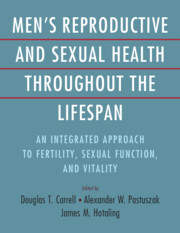 Men's Reproductive and Sexual Health Throughout the Lifespan
Men's Reproductive and Sexual Health Throughout the Lifespan Book contents
- Men’s Reproductive and Sexual Health throughout the Lifespan
- Men’s Reproductive and Sexual Health throughout the Lifespan
- Copyright page
- Contents
- Contributors
- Preface
- Section 1 An Introduction to Men’s Health Care
- Section 2 The Biology of Male Reproduction and Infertility
- Chapter 4 Current Understanding of the Physiology and Histology of Human Spermatogenesis
- Chapter 5 Male Reproductive Endocrinology
- Chapter 6 Sperm Chromatin Packaging and the Toroid Linker Model
- Chapter 7 Ejaculation and Sperm Transport
- Chapter 8 Genetic Aspects of Male Infertility
- Chapter 9 The Mechanistic and Predictive Utility of Sperm Epigenetics
- Chapter 10 Aging and Environmental Interactions with the Sperm Epigenome
- Chapter 11 The Effects of Aging on Male Fertility and the Health of Offspring
- Section 3 Clinical Evaluation and Treatment of Male Infertility
- Section 4 Laboratory Evaluation and Treatment of Male Infertility
- Section 5 Medical and Surgical Management of Issues of Male Health
- Index
- References
Chapter 6 - Sperm Chromatin Packaging and the Toroid Linker Model
from Section 2 - The Biology of Male Reproduction and Infertility
Published online by Cambridge University Press: 06 December 2023
- Men’s Reproductive and Sexual Health throughout the Lifespan
- Men’s Reproductive and Sexual Health throughout the Lifespan
- Copyright page
- Contents
- Contributors
- Preface
- Section 1 An Introduction to Men’s Health Care
- Section 2 The Biology of Male Reproduction and Infertility
- Chapter 4 Current Understanding of the Physiology and Histology of Human Spermatogenesis
- Chapter 5 Male Reproductive Endocrinology
- Chapter 6 Sperm Chromatin Packaging and the Toroid Linker Model
- Chapter 7 Ejaculation and Sperm Transport
- Chapter 8 Genetic Aspects of Male Infertility
- Chapter 9 The Mechanistic and Predictive Utility of Sperm Epigenetics
- Chapter 10 Aging and Environmental Interactions with the Sperm Epigenome
- Chapter 11 The Effects of Aging on Male Fertility and the Health of Offspring
- Section 3 Clinical Evaluation and Treatment of Male Infertility
- Section 4 Laboratory Evaluation and Treatment of Male Infertility
- Section 5 Medical and Surgical Management of Issues of Male Health
- Index
- References
Summary
We have previously reported in several publications the existence of a nuclease that is present in the luminal fluid of the epididymis and in higher concentrations in the lumina fluid of the vas deferens in the mouse. This luminal nuclease has the ability to digest the sperm DNA into loop-sized fragments but is restricted to digesting DNA that is not bound by protamines. In this chapter, we describe new data that show that the luminal nuclease is active in SDS for up to 30 min, complicating the analysis of sperm DNA damage that must be extracted by SDS for electrophoretic analysis on gels. High concentrations of EDTA can protect the DNA from the luminal nuclease if added before SDS is applied. This new data provides an update on our toroid loop model for sperm chromatin structure. We discuss the implications of this updated model for the study of sperm chromatin structure and for clinical assays for sperm DNA damage.
Keywords
- Type
- Chapter
- Information
- Men's Reproductive and Sexual Health Throughout the LifespanAn Integrated Approach to Fertility, Sexual Function, and Vitality, pp. 54 - 60Publisher: Cambridge University PressPrint publication year: 2023


